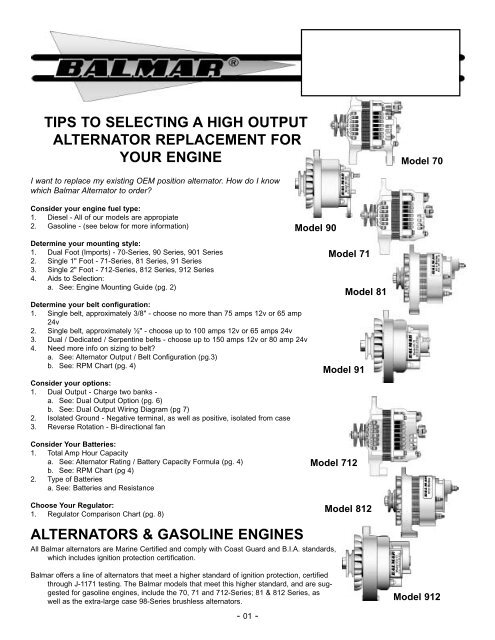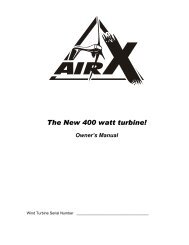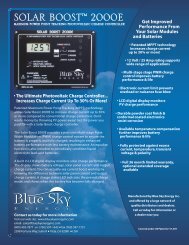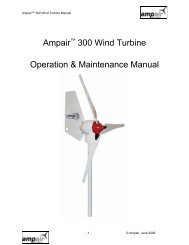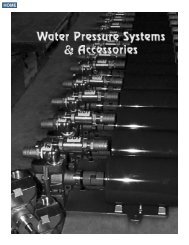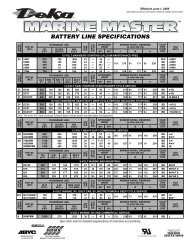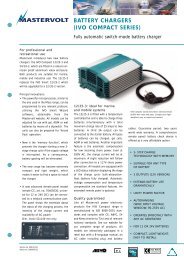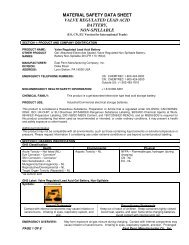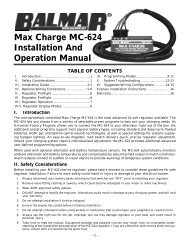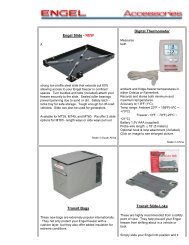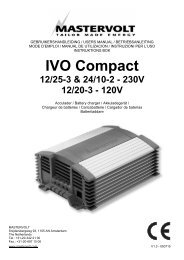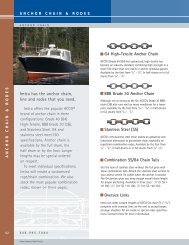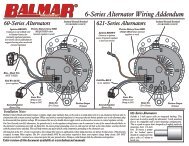a helpful Alternator-Regulator Guide - Marine Warehouse
a helpful Alternator-Regulator Guide - Marine Warehouse
a helpful Alternator-Regulator Guide - Marine Warehouse
Create successful ePaper yourself
Turn your PDF publications into a flip-book with our unique Google optimized e-Paper software.
TIPS TO SELECTING A HIGH OUTPUTALTERNATOR REPLACEMENT FORYOUR ENGINEModel 70I want to replace my existing OEM position alternator. How do I knowwhich Balmar <strong>Alternator</strong> to order?Consider your engine fuel type:1. Diesel - All of our models are appropiate2. Gasoline - (see below for more information)Model 90Determine your mounting style:1. Dual Foot (Imports) - 70-Series, 90 Series, 901 Series2. Single 1" Foot - 71-Series, 81 Series, 91 Series3. Single 2" Foot - 712-Series, 812 Series, 912 Series4. Aids to Selection:a. See: Engine Mounting <strong>Guide</strong> (pg. 2)Determine your belt configuration:1. Single belt, approximately 3/8" - choose no more than 75 amps 12v or 65 amp24v2. Single belt, approximately ½" - choose up to 100 amps 12v or 65 amps 24v3. Dual / Dedicated / Serpentine belts - choose up to 150 amps 12v or 80 amp 24v4. Need more info on sizing to belt?a. See: <strong>Alternator</strong> Output / Belt Configuration (pg.3)b. See: RPM Chart (pg. 4)Consider your options:1. Dual Output - Charge two banks -a. See: Dual Output Option (pg. 6)b. See: Dual Output Wiring Diagram (pg 7)2. Isolated Ground - Negative terminal, as well as positive, isolated from case3. Reverse Rotation - Bi-directional fanConsider Your Batteries:1. Total Amp Hour Capacitya. See: <strong>Alternator</strong> Rating / Battery Capacity Formula (pg. 4)b. See: RPM Chart (pg 4)2. Type of Batteriesa. See: Batteries and ResistanceChoose Your <strong>Regulator</strong>:1. <strong>Regulator</strong> Comparison Chart (pg. 8)Model 71Model 81Model 91Model 712Model 812ALTERNATORS & GASOLINE ENGINESAll Balmar alternators are <strong>Marine</strong> Certified and comply with Coast Guard and B.I.A. standards,which includes ignition protection certification.Balmar offers a line of alternators that meet a higher standard of ignition protection, certifiedthrough J-1171 testing. The Balmar models that meet this higher standard, and are suggestedfor gasoline engines, include the 70, 71 and 712-Series; 81 & 812 Series, aswell as the extra-large case 98-Series brushless alternators.Model 912- 01 -
The following guide provides a basic reference for matchingHigh-Output Balmar alternators to your specific enginetype. Keep in mind that "real world" factors, includingengine age, engine model, engine marinizer, distributorand/or installer, can all have a dramatic effect on the actualmounting configuration you'll find on your specific engine.In addition to your alternator's mounting style, it is essentialto ensure that your alternator's amperage capacity ismatched to the size of your drive belt. If your engine uses a<strong>Alternator</strong> Mounting <strong>Guide</strong>3/8" drive belt, we recommend our 75-amp alternator. Ifyour existing drive belt measures 1/2", we recommend our100-amp alternator. If your engine is equipped with a dual1/2"-belt system, our 150-amp alternator would be the recommendedchoice for your system. Large case, high-outputalternators should be driven by a minimum of two 1/2" belts.We strongly recommend you examine your engine to determineboth mounting style and drive belt size before youorder a replacement or upgrade alternator.Engine /Alt. Make Series (Case size or type) Mounting Foot Size ( M.F.)Bukh 71, 91 series 1" M.F.Caterpillar Not Standard, usually isolated ground, 91 or large case Varies by modelChrysler 70, 90 series with spacers Varies by modelCrusader 71, 81 or 91 series 1" M.F.Cummins 92/94 TCU series( dual foot), 95 series or 912 Varies by modelDelco 55 Alt. (W/2" M.F.) 912 series 2" (Delco style) M.F. (or 91 w/ 1" M.F. & 1" spacer) 2" M.F.Detroit Diesel 92/94 series (specify dual foot), some 912 series Varies by modelFlagship 71, 91 series 1" M.F.GMC 71, 91 series for most (can use 92/94 series ) Varies by modelGreymarine 71, 91 series 1" M.F.Hawk <strong>Marine</strong> Power 71, 91 series 1" M.F.Hitachi <strong>Alternator</strong> 70, 90 series (dual foot 3.15" separation)Indmar 71, 91 series 1" M.F.Isuzu 70, 71, 91 series 1" M.F., drill hole to 1/2"John Deere 71, 91 series 1" M.F.Lehman(Ford) 71, 91 series 1" M.F. Call American DieselLehman(Sabre) 901-75 or 901-100 series (dual foot 3.15" separation)Lugger 6125Lugger mounting kit for the 6125 465 hp engineLucas Alt. 901-75 or 901-100 series (all isolated ground) (dual foot 3.15" separation)Mann No standard. (Can use 92/94 series )Mercedes 90 series (dual foot 3.15" separation), with spacers commonMercrusier 71, 81 or 91 series 1" M.F.Mitsubishi 70, 90 series case (dual foot 3.15" separation) 1" spacer 3/8 boltMotorola <strong>Alternator</strong> 71, 91 series 1" M.F.MTU No standard (Can use 92/94 series )Namni 70, 90 series (dual foot 3.15" separation)Nippondenso Alt. 70, 90 series (dual foot 3.15" separation), Modify engine mount.OMC 71, 91 series 1" M.F.Pathfinder* 912 series 2" (Delco style) M.F.Perkins 4-107,108 912 series 2" (Delco style) M.FPerkins (other) 71, 91 series 1" M.F.Perkins-Volvo M series 901-75 or 901-100 series (dual foot 3.15" separation), isolated groundsPleasurecraft 71, 91 series 1" M.F.Prestolite Alt. 71, 91 series 1" M.F.Universal Atomic 4 712, 812, 91 or 912 series 1" M.F. with 1" spacerUniversal 30, 50 -1982 71, 91 series1" M.F.Vetus-Denouden 70, 90 series (dual foot 3.15" separation)Volvo - 2001 -2003 712, 912 series 2" ( Delco style) M.F. (turbo - swing arm mod.)Volvo - Driven off Flywheel<strong>Alternator</strong> must have a special 3/8" x 4" pulleyWesterbeke 46 4107, 4108 (1979)91series1" M.F.Westerbeke 46 (1986) 70, 90 series (dual foot 3.15" separation)Yamaha (IO) 71, 91 series 1" M.F.Yanmar ** 70, 90 series (dual foot 3.15" separation)*Remove original pulley and mount on BALMAR ® alternator; or move U bracket forward**Yanmar Mounting: 35 amp uses 6 mm Mt. bolt, 55 amp 8 mm Mt. bolt, 80 amp special 10 mm bushing.- 02 -
<strong>Alternator</strong> Rating / Battery Capacity FormulaRule of thumb is that the alternator output equal 25% of the battery capacity, so for a 400 amp hourbank, our 100 amp alternator would be a wise choice. You can figure 1 hp draw per 25 amps (12 volt)at maximum output.Be sure to read the information about batteries and resistance, on the following page. There are manyfactors that play into the correct sizing of the alternator to the battery bank.Automotive type alternators that come standard on enginesare typically designed for light load handling and are not upto the task of charging large banks of batteries. It is simplynot what they are designed to do. Rule of thumb is that mostpeople see at least a 50% increase in performance due toreplacing an automotive type alternator with a similarly ratedhigh output marine alternator.Our rpm table rates the output at 122 degrees F and at 14or 28 volts. The highest rated alternator that we recommendon a single belt in the factory alternator position is 100amps. That is if the belt is ½". If the belt is 3/8", we wouldrecommend the 75 amp model be used. The Balmar 100amp alternator can actually put out about 120 amps. HOW-EVER, the alternator will only put out as much current as thebatteries can accept. There are many factors that determinehow much current the batteries will accept.Often it is not the output of the alternator, or even its regulationthat causes the disappointing recharge scenario. Thiscan many times be attributed to the rate of charge the batteriescan accept. Typically, batteries absorb current at arate of about 20-30% of their capacity. Your battery manufacturercan answer questions that you may have in thisregard.BATTERIES & RESISTANCEYou can picture a 200-amp alternator charging one smallcar battery, you will never see that battery accepting morethan 30 or 40 amps. Yet a 1000 amp hr battery bank, whendeeply discharged can make that 200 amp alternator workat it maximum output. If the alternator has a 100 amp capacity,and the batteries can absorb 60 amps, and you have anadditional 40 amp load, there would be a 100 amp output.There are, however, many factors that will affect this andsome of them are somewhat abstract.The first, and probably most important, is to realize that theabsorption rate of the particular type of batteries sets thecharge rate. In other words, if we were to set the voltage at14.1, the batteries, would absorb current at a certain rate. Ifyou raise the voltage the batteries will absorb more currentbut you may damage them. Different types of batteriesmade by different manufacturers have a wide span ofabsorption rates.One other small factor to consider is that a 100 amp alternatoris rated at 100 amps when it has adequate voltage tocreate the magnetic flux. In other words, if your battery wasdown to 10 volts, the alternator would not have the energy(10 volts) required to come to its full potential. In a way, ithas to earn its way up to its full potential.With the new AGM type batteries, we see a very substantialincrease in this percentage. (Note: when using AGM batteries,we highly recommend using our Max Charge regulatorwith battery and alternator temperature sensing.) The largerthe battery bank, the more current the batteries willaccept and the harder the alternator has to work.So you see there are many abstracts. It is often disappointingto try to achieve that last 10 or 15% back into your batteries.We find that adding more batteries, in other words alarger resistive target for the alternator, increases the currentflow and shortens the length of time that the enginemust operate to replenish yesterdays use of energy.Notes:- 05 -
Dual Output Option / Charging Multiple Battery BanksThere are four ways to accomplish the charging ofmultiple battery systems:1) Dual Output <strong>Alternator</strong>2) Battery Isolator3) Battery Combiner4) A/B SwitchEveryone has their own preference and opinion aboutwhich is best. The old 'A/B Switch' is extremely reliable,but some people don't like to have to try toremember to use it. Any of the methods listed abovewill work. We prefer the dual output alternator method,where the output simply goes from the alternator to thetwo individual battery banks requiring charging - thereis nothing to be remembered and there is no additionalequipment to fail.There are several ways to charge two groups of batterieswith one alternator. Using a dual output alternatoris probably one of the simplest, as the outputs cango directly to each battery terminal. Therefore, wheneverthe alternator is in operation, both sets of batteriesare being topped out, without having to rememberwhere the switch setting is set.The dual output alternator is rather simplistic in itsdesign. It offers two complete sets of isolated diodesand cooling plates . Whichever terminal sees a loadwill receive the current flow. Either terminal on thealternator can put out 100% of the alternator's capacity.Some people that use extremely heavy loads on thealternator choose to use it as a single output model,leaving the bonding strap on the two terminals, thusdoubling the cooling capacity of the alternator.A very standard scenario is that the cranking battery isfully charged, or nearly fully charged, and the housebank is brought down from regular daily activity. Whatoccurs is that the house battery will consume all of thealternator output until it is brought up to the same voltagelevel as the cranking battery. At that point, thealternator will bring both banks up and top them offtogether. As you can imagine, the cranking batterytakes very little of the current, therefore the full capacityof the alternator is directed to the house load.You do not need a separate regulator for each output.The regulator provides instructions to the alternator,and the alternator can only act upon one set of instructions.We usually regulate the heavy load, the housebank, and the regulator assures that the voltage on thesystem does not exceed the values set on the regulator.Again, with a dual output alternator, the red sensewire is used to sense the most heavily used (usuallythe house) bank. Connection may be may at the alternatoroutput terminal, if the wiring is correctly sized. Ifthe wiring is not correctly sized, there may be line lossto the battery. An alternative is to connect the red wireto battery positive.The voltage level from the alternator is determined bythe regulator. If the regulator is set at 14.2, both outputswill charge at 14.2 volts. The batteries acceptancerate of current is determined by the voltage setting.In other words, if the voltage setting of the regulatoris 14.2 volts, a battery at 14.2 volts will acceptvery little current. On the other hand, if the battery isquite low, let's say at 12.2, it will accept 'X' amount ofcurrent, depending on the type and size of battery, anat a diminishing rate as it comes up to the set voltage.The higher the voltage is set, the more the battery willabsorb. That is the fundamental philosophy of the 3stage regulator. The batteries will simply come up tothe given voltage. If they are both fully charged, verylittle current will flow. If one bank is low, the current willflow to that battery first. It doesn't matter if it is thehouse or the start battery.Different types of batteries are a different story. Batterymanufacturers and Balmar both suggest that all batteriesin a system be of the same type. Different typesof batteries often have different program parameterssuggested for proper voltages and absorption rates.For more information about small and large case dual-output alternators,see our website at: www.balmar.net- 06 -
Suggested Wiring for 12V Dual-Output <strong>Alternator</strong> / Two BatteriesNOTE: Typical installations are most efficient when battery sensing takes place at larger (house) bank. If smaller (starting)battery indicates overcharging, move sense wire to smaller battery.- 07 -
- 08 -


